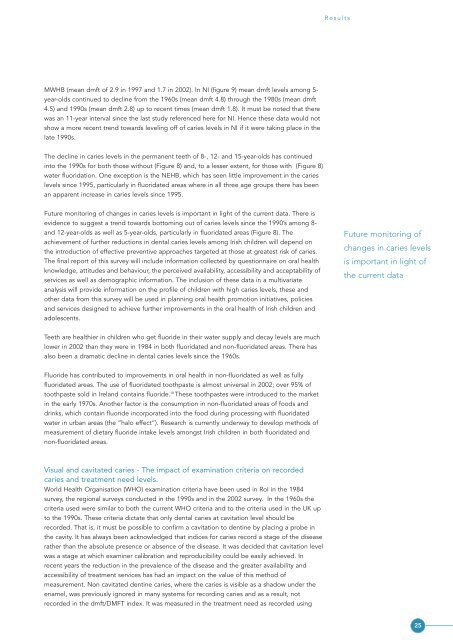Oral Health inside - Communities and Local Government
Oral Health inside - Communities and Local Government
Oral Health inside - Communities and Local Government
You also want an ePaper? Increase the reach of your titles
YUMPU automatically turns print PDFs into web optimized ePapers that Google loves.
ResultsMWHB (mean dmft of 2.9 in 1997 <strong>and</strong> 1.7 in 2002). In NI (figure 9) mean dmft levels among 5-year-olds continued to decline from the 1960s (mean dmft 4.8) through the 1980s (mean dmft4.5) <strong>and</strong> 1990s (mean dmft 2.8) up to recent times (mean dmft 1.8). It must be noted that therewas an 11-year interval since the last study referenced here for NI. Hence these data would notshow a more recent trend towards leveling off of caries levels in NI if it were taking place in thelate 1990s.The decline in caries levels in the permanent teeth of 8-, 12- <strong>and</strong> 15-year-olds has continuedinto the 1990s for both those without (Figure 8) <strong>and</strong>, to a lesser extent, for those with (Figure 8)water fluoridation. One exception is the NEHB, which has seen little improvement in the carieslevels since 1995, particularly in fluoridated areas where in all three age groups there has beenan apparent increase in caries levels since 1995.Future monitoring of changes in caries levels is important in light of the current data. There isevidence to suggest a trend towards bottoming out of caries levels since the 1990’s among 8-<strong>and</strong> 12-year-olds as well as 5-year-olds, particularly in fluoridated areas (Figure 8). Theachievement of further reductions in dental caries levels among Irish children will depend onthe introduction of effective preventive approaches targeted at those at greatest risk of caries.The final report of this survey will include information collected by questionnaire on oral healthknowledge, attitudes <strong>and</strong> behaviour, the perceived availability, accessibility <strong>and</strong> acceptability ofservices as well as demographic information. The inclusion of these data in a multivariateanalysis will provide information on the profile of children with high caries levels, these <strong>and</strong>other data from this survey will be used in planning oral health promotion initiatives, policies<strong>and</strong> services designed to achieve further improvements in the oral health of Irish children <strong>and</strong>adolescents.Future monitoring ofchanges in caries levelsis important in light ofthe current dataTeeth are healthier in children who get fluoride in their water supply <strong>and</strong> decay levels are muchlower in 2002 than they were in 1984 in both fluoridated <strong>and</strong> non-fluoridated areas. There hasalso been a dramatic decline in dental caries levels since the 1960s.Fluoride has contributed to improvements in oral health in non-fluoridated as well as fullyfluoridated areas. The use of fluoridated toothpaste is almost universal in 2002; over 95% oftoothpaste sold in Irel<strong>and</strong> contains fluoride. 18 These toothpastes were introduced to the marketin the early 1970s. Another factor is the consumption in non-fluoridated areas of foods <strong>and</strong>drinks, which contain fluoride incorporated into the food during processing with fluoridatedwater in urban areas (the “halo effect”). Research is currently underway to develop methods ofmeasurement of dietary fluoride intake levels amongst Irish children in both fluoridated <strong>and</strong>non-fluoridated areas.Visual <strong>and</strong> cavitated caries - The impact of examination criteria on recordedcaries <strong>and</strong> treatment need levels.World <strong>Health</strong> Organisation (WHO) examination criteria have been used in RoI in the 1984survey, the regional surveys conducted in the 1990s <strong>and</strong> in the 2002 survey. In the 1960s thecriteria used were similar to both the current WHO criteria <strong>and</strong> to the criteria used in the UK upto the 1990s. These criteria dictate that only dental caries at cavitation level should berecorded. That is, it must be possible to confirm a cavitation to dentine by placing a probe inthe cavity. It has always been acknowledged that indices for caries record a stage of the diseaserather than the absolute presence or absence of the disease. It was decided that cavitation levelwas a stage at which examiner calibration <strong>and</strong> reproducibility could be easily achieved. Inrecent years the reduction in the prevalence of the disease <strong>and</strong> the greater availability <strong>and</strong>accessibility of treatment services has had an impact on the value of this method ofmeasurement. Non cavitated dentine caries, where the caries is visible as a shadow under theenamel, was previously ignored in many systems for recording caries <strong>and</strong> as a result, notrecorded in the dmft/DMFT index. It was measured in the treatment need as recorded using25
















